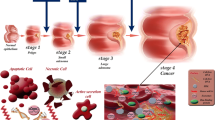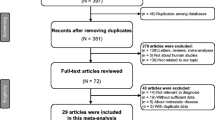Abstract
Purpose
The purpose of this study was to explore the potential role of deranged fecal microRNA (miRNA) pattern as a reliable warning signal of colorectal cancer (CRC), a subset of fecal CRC-related miRNAs was evaluated in CRC patients, before and after surgery, and in healthy controls.
Methods
Twenty CRC patients and 20 age/sex-matched healthy volunteers with negative colonoscopy entered the study. Cancer biopsy, colonic mucosa from the resected specimens, and fecal samples from patients and controls were screened for 13 miRNAs involved in CRC onset and progressions by reverse transcription quantitative PCR (RT-qPCR). Postoperative evaluation of fecal miRNAs was carried out after a median follow-up of 18 months (range 12–30).
Results
Two out 13 miRNAs (RNU6B, miR-16-3p) were used as internal controls leaving 11 available for analysis. Cancer tissue contained significantly higher expression of all miRNAs, compared to normal mucosa (p < 0.05). Expression of preoperative levels of five fecal miRNAs, (miR-19-b-3p, miR-20a-5p, miR-21-3p, miR92a-3p, miR141) was significantly higher in CRC patients compared to controls and significantly decreased after curative surgery. Three out of these five miRNAs (miR20a-5p, miR21-3p, and miR141) returned to values comparable to normal controls.
Conclusions
A set of three specific fecal miRNAs is overexpressed before surgery, and return within the normal range after cancer removal could be considered as an appealing opportunity for a new reliable tool for CRC secondary prevention. However, their role needs to be explored in large prospective trials and compared with the existing screening tools.






Similar content being viewed by others
References
Krol J, Loedige I, Filipowicz W (2010) The widespread regulation of microRNA biogenesis, function and decay. Nat Rev Genet 11:597–610. doi:10.1038/nrg2843
Wu WK, Law PT, Lee CW et al (2011) MicroRNA in colorectal cancer: from benchtop to bedside. Carcinogenesis 32:247–253. doi:10.1093/carcin/bgq243
Dong Y, Wu WK, Wu CW, Sung JJ, Yu J, Ng SS (2011) MicroRNA dysregulation in colorectal cancer: a clinical perspective. Br J Cancer 104:893–898. doi:10.1038/bjc.2011.57
Bonfrate L, Altomare DF, Di Lena M et al (2013) MicroRNA in colorectal cancer: new perspectives for diagnosis, prognosis and treatment. J Gastrointestin Liver Dis 22:311–320
Agostini M, Pucciarelli S, Calore F, Bedin C, Enzo M, Nitti D (2010) miRNAs in colon and rectal cancer: a consensus for their true clinical value. Clin Chim Acta 411:1181–1186. doi:10.1016/j.cca.2010.05.002
Volinia S, Calin GA, Liu CG et al (2006) A microRNA expression signature of human solid tumors defines cancer gene targets. Proc Natl Acad Sci U S A 103:2257–2261
Faber C, Kirchner T, Hlubek F (2009) The impact of microRNAs on colorectal cancer. Virchows Arch 454:359–367
Schee K, Boye K, Abrahamsen TW, Fodstad O, Flatmark K (2012) Clinical relevance of microRNA miR-21, miR-31, miR-92a, miR-101, miR-106a and miR-145 in colorectal cancer. BMC Cancer 12:505. doi:10.1186/1471-2407-12-505
Nugent M, Miller N, Kerin MJ (2011) MicroRNAs in colorectal cancer: function, dysregulation and potential as novel biomarkers. Eur J Surg Oncol 37:649–654. doi:10.1016/j.ejso.2011.05.005
Schetter AJ, Okayama H, Harris CC (2012) The role of microRNAs in colorectal cancer. Cancer J 18:244–252
Mazeh H, Mizrahi I, Ilyayev N et al (2013) The diagnostic and prognostic role of microRNA in colorectal cancer—a comprehensive review. J Cancer 4:281–295. doi:10.7150/jca.5836
Wang Q, Huang Z, Ni S et al (2012) Plasma miR-601 and miR-760 are novel biomarkers for the early detection of colorectal cancer. PLoS One 7, e44398. doi:10.1371/journal.pone.0044398
Ye JJ, Cao J (2014) MicroRNAs in colorectal cancer as markers and targets: recent advances. World J Gastroenterol 20:4288–4299. doi:10.3748/wjg.v20.i15.4288
Patel RS, Jakymiw A, Yao B et al (2011) High resolution of microRNA signatures in human whole saliva. Arch Oral Biol 56:1506–1513. doi:10.1016/j.archoralbio.2011.05.015
Wang G, Chan ES, Kwan BC et al (2012) Expression of microRNAs in the urine of patients with bladder cancer. Clin Genitourin Cancer 10:106–113. doi:10.1016/j.clgc.2012.01.001
Roth C, Rack B, Muller V, Janni W, Pantel K, Schwarzenbach H (2010) Circulating microRNAs as blood-based markers for patients with primary and metastatic breast cancer. Breast Cancer Res 12:R90. doi:10.1186/bcr2766
Di Lena M, Travaglio E, Altomare DF (2013) New strategies for colorectal cancer screening. World J Gastroenterol 19:1855–1860. doi:10.3748/wjg.v19.i12.1855
Ahmed FE, Ahmed NC, Vos PW et al (2013) Diagnostic microRNA markers to screen for sporadic human colon cancer in stool: I. Proof of principle. Cancer Genomics Proteomics 10:93–113
Link A, Balaguer F, Shen Y et al (2010) Fecal microRNAs as novel biomarkers for colon cancer screening. Cancer Epidemiol Biomarkers Prev 19:1766–1774. doi:10.1158/1055-9965.EPI-10-0027
Koga Y, Yasunaga M, Takahashi A et al (2010) MicroRNA expression profiling of exfoliated colonocytes isolated from feces for colorectal cancer screening. Cancer Prev Res (Phila) 3:1435–1442. doi:10.1158/1940-6207.CAPR-10-0036
Wu CW, Ng SS, Dong YJ et al (2012) Detection of miR-92a and miR-21 in stool samples as potential screening biomarkers for colorectal cancer and polyps. Gut 61:739–745. doi:10.1136/gut.2011.239236
Wang WT, Zhao YN, Yan JX et al (2014) Differentially expressed microRNAs in the serum of cervical squamous cell carcinoma patients before and after surgery. J Hematol Oncol 7:6. doi:10.1186/1756-8722-7-6
Le HB, Zhu WY, Chen DD et al (2012) Evaluation of dynamic change of serum miR-21 and miR-24 in pre- and post-operative lung carcinoma patients. Med Oncol 29:3190–3197. doi:10.1007/s12032-012-0303-z
Ng EK, Chong WW, Jin H et al (2009) Differential expression of microRNAs in plasma of patients with colorectal cancer: a potential marker for colorectal cancer screening. Gut 58:1375–1381. doi:10.1136/gut.2008.167817
de Krijger I, Mekenkamp LJ, Punt CJ, Nagtegaal ID (2011) MicroRNAs in colorectal cancer metastasis. J Pathol 224:438–447. doi:10.1002/path.2922
Koga Y, Yamazaki N, Yamamoto Y et al (2013) Fecal miR-106a is a useful marker for colorectal cancer patients with false-negative results in immunochemical fecal occult blood test. Cancer Epidemiol Biomarkers Prev 22:1844–1852. doi:10.1158/1055-9965.EPI-13-0512
Yamazaki N, Koga Y, Yamamoto S et al (2013) Application of the fecal microRNA test to the residuum from the fecal occult blood test. Jpn J Clin Oncol 43:726–733. doi:10.1093/jjco/hyt068
Pigati L, Yaddanapudi SC, Iyengar R et al (2010) Selective release of microRNA species from normal and malignant mammary epithelial cells. PLoS One 5, e13515. doi:10.1371/journal.pone.0013515
Dawson B, Trapp RG (2001) Basic & clinical biostatistics. McGraw-Hill, New York
Kalimutho M, Del Vecchio Blanco G, Di Cecilia S et al (2011) Differential expression of miR-144* as a novel fecal-based diagnostic marker for colorectal cancer. J Gastroenterol 46:1391–1402. doi:10.1007/s00535-011-0456-0
Li JM, Zhao RH, Li ST et al (2012) Down-regulation of fecal miR-143 and miR-145 as potential markers for colorectal cancer. Saudi Med J 33:24–29
Phua LC, Chue XP, Koh PK, Cheah PY, Chan EC, Ho HK (2014) Global fecal microRNA profiling in the identification of biomarkers for colorectal cancer screening among Asians. Oncol Rep 32:97–104. doi:10.3892/or.2014.3193
Acknowledgments
The results of this paper have been presented in part at the Annual Scientific Meeting of the European Society of Clinical Investigation, Utrecht (The Netherlands), 1–3 May 2014. This work was supported by a research grant “Fondazione Cassa di Risparmio di Puglia,” 2012, for the project “Studio dei microRNA sierici e fecali nei pazienti con carcinoma del colon retto.”
Ethical approval
All procedures performed in studies involving human participants were in accordance with the ethical standards of the institutional and/or national research committee and with the 1964 Helsinki Declaration and its later amendments or comparable ethical standards.
Author contributions
Maria Teresa Rotelli had substantial contributions to the study conception and design, analysis and interpretation of data, drafting of the article, and final approval of the version to be published. Maria Di Lena had substantial contributions to the conception and design of the study, acquisition of data, revising the study critically for important intellectual content, and final approval of the version to be published. Aldo Cavallini and Catia Lippolis also contributed in the data analysis and interpretation of data, drafting the article, and final approval of the version to be published. Leonilde Bonfrate contributed in drafting the article and revising it critically for important intellectual content and in the final approval of the version to be published. Nicola Chetta contributed in the acquisition of data, analysis and interpretation of data, and final approval of the version to be published. Piero Portincasa had substantial contributions to the conception and design of the study, revising the paper critically for important intellectual content, and final approval of the version to be published. Donato Francesco Altomare contributed to the conception and design of the study, analysis and interpretation of data, drafting the article, and final approval of the version to be published.
Author information
Authors and Affiliations
Corresponding author
Rights and permissions
About this article
Cite this article
Rotelli, M.T., Di Lena, M., Cavallini, A. et al. Fecal microRNA profile in patients with colorectal carcinoma before and after curative surgery. Int J Colorectal Dis 30, 891–898 (2015). https://doi.org/10.1007/s00384-015-2248-0
Accepted:
Published:
Issue Date:
DOI: https://doi.org/10.1007/s00384-015-2248-0




